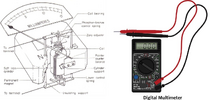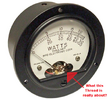The keyword?
View attachment 58848
Voltmeter - try to use anything that is analog, seriously.
Why? It can help "dampen" spikes and noise Prescence in the signal - for as you work to find the higher levels to peak to - references in the Service manual (Signal not it's noise or other artifacts like Noise floor hiss) you can use the Analog's meter own lag to develop that "Average RMS" due to this D'Arsonval movement design as a generalized indication of; "You're going the right way" or "You're too far into the weeds to pull you out"
We could get into the "nitty gritty" on differences that engineers have to design into electronics the new meters to mimic what replaces that, to use solid state versus analog movements that have been refined thru the ages to become the very things most people argue and fight over - both "on-Air" and the techs that do the very thing you are attempting to do on your own - everyday.
View attachment 58850
Simply because some meters are more divisive
about what is really being measured versus,
the ability to view a general rate of change to
indicate the direction you are trying to go.
So, since you're already using older radio equipment to begin with, the investment is really only your time and effort in familiarizing and even possibly cleaning the leads of the test jumpers to restore the OEM quality they originally had to get those reading correctly measured without the resistive effects left over from the "Oxides Of March" moving on thru April into May...
You also can use the radios own meters to VERIFY that which the older analog meter can - so you can use both more effectively in your restoration project.
Be sure to wish your mom a Happy Mothers' Day
View attachment 58851
Or at least remember her...





